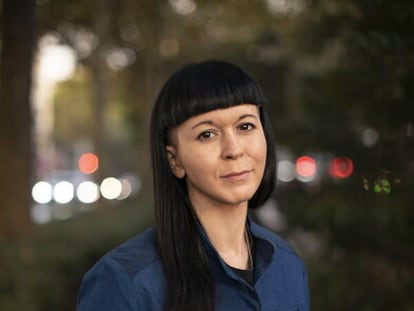Photographer Carolyn Drake undresses masculinity
An exhibition and a photobook explore the American artist’s use of portraiture and the male nude to question traditional forms of representing women

A disturbing and suffocating portrait welcomes visitors to Men Untitled, one of the exhibits at the Henri Cartier-Bresson Foundation in Paris. In it, a figure covered from head to toe in a blue cloth poses in a seated position, leaving only his hands uncovered. It is Los Angeles-born photographer Carolyn Drake’s interpretation of a ghost mother, the term used to refer to the practice of keeping children still and under control at the dawn of photography when long exposures were required for a portrait; it consisted of mothers holding their offspring in their laps, covered like specters or human furniture draped in dark fabrics. Using a man as a model, Drake, 51, evokes that unfortunate chapter in the history of the medium. The piece serves as an introduction to a photographic journey that reverses gender roles and uses the male nude to redefine the contemporary gaze and question the traditional forms of representing the female body.
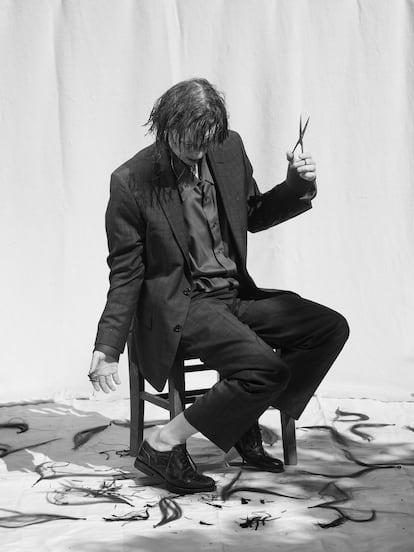

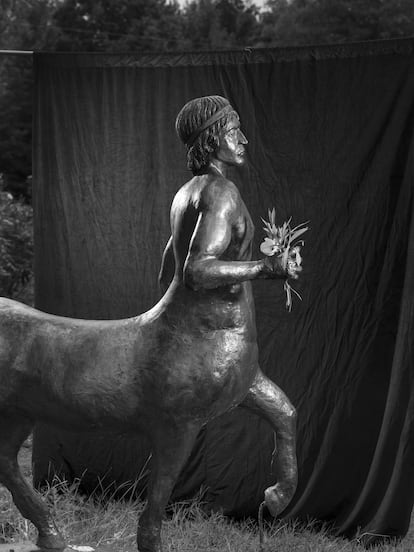

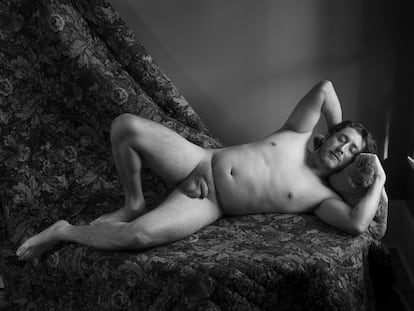
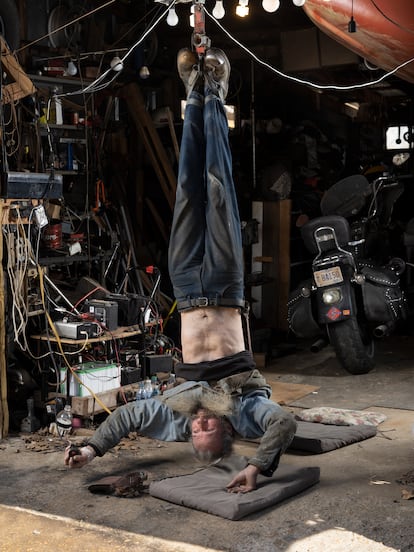

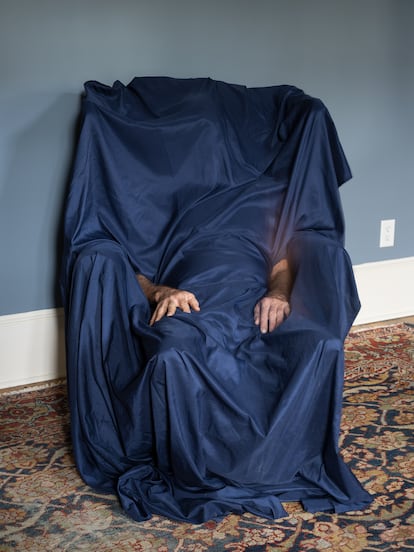
Two years after the magnificent exhibition that the foundation dedicated to the work of influential British critic, editor and photographer John Coplans — who made his own nudity the sole motif of his work — a woman is now scrutinizing the male anatomy. Just as the influential Artforum editor did, Drake shows flabby, wrinkled bodies that subvert aesthetic conventions. And while both gazes can be as provocative and grotesque as they are amusing, Drake’s is as empathetic towards her subjects as it is rabid. That dialectical tension is precisely the strength of Drake’s work as she confronts her own culture (a country where a man accused of sexual assault became a Supreme Court justice, even as #MeToo gained strength). She does so by combining a documentary approach with fiction, a formula that is becoming the hallmark of several members of Magnum, the agency to which the photographer belongs.
“The project is as much about the male body as it is about how to shed masculinity,” the photographer points out during a telephone conversation. While in her acclaimed previous project, Knit Club, the artist focused her gaze on a group of women in Mississippi — and practically dispensed with the most predictable resource of showing their bodies directly — for Men Untitled, Drake started by going back to the same place to portray the men who had participated in Knit Club without being visible. A year later, upon her return to California, the photographer began to consider undressing her subjects and isolating them from any geographical environment and any element that could empower them. “I was interested in reflecting their fragility and vulnerability,” she explains. “Through the nude, I could find a balance with the subject, a balance that helped me to assuage my own anger while at the same time allowing me to establish a friendship with and grow my empathy toward the subjects.” Similarly, the humor and playfulness in some of the images, such as the one of a man posing as a mermaid covered in mud, helped break the tension.

Some of Drake’s portraits were inspired by Eadweard Muybridge’s motion sequences, in which the gender differences of the time are clearly defined, and by E. J Bellocq’s photographs of prostitutes in early-20th-century New Orleans. “[That] series of images appealed to me for their strength as much as they disgusted me,” the photographer explains. “I tried to mimic the poses and lighting. There is no history that traces the female representation of male bodies, hence my purpose was not only to reverse the roles, but also to expand that content and language.”
In the centerfold image in the Men Untitled photobook (published by TBW), a man poses clothed and hanging upside down from a hook. It is a nod to the centerfolds of men’s magazines like Playboy and Penthouse. For years, it was common to see them hanging as posters in places like car repair shops, as in the case of Wallace’s motorcycle garage, the subject of the photo. “Wallace told me that, on one occasion, he had his girlfriend pose like this, and he also invited me to pose, dressed up. I did it in exchange for this image,” the photographer admits.
“I explained to my models that my intention was to express my opinion and offer a response to the patriarchal and misogynistic structures of society, so they would understand why I didn’t intend for them to look splendid in the portraits,” Drake notes. “Some of them didn’t recognize themselves, but my purpose was not to please them; [it was] to express and visualize my ideas and conflicts. I only portrayed older men because I was interested in the fragility of their bodies, observing them from above or reclining, as is usually done with women. Frequently, the models do not return the photographer’s gaze, a formula often used to construct a woman’s image, where the viewer can penetrate the photograph, and yet the subject cannot recover her power to respond.”

A section in which the walls are covered with reproductions of the black and white pages of a beauty and seduction manual, published in the United States in the 1950s, complements the exhibit. This space includes texts that the photographer herself wrote, as well as a series of self-portraits, in which she distorts and camouflages her face so that it is hard to identify her gender. “I wanted to include myself in the project as a reference for internal reflection,” the author explains. “The idea was to create a space from where you can observe men, on the outside walls, while the inside offers the possibility to reflect on oneself and establish a dialogue and a new kind of relationship.”
Drake’s work is charged with a strong enigmatic element that peaks in powerful surreal images, such as a tapestry hanging from a tree in the dark of night, a piano burning at night and a strange artifact that might be an alchemist’s bowl, where the photographer performs a transmutation by inserting a man’s head. The photographs shatter the viewer’s expectations about masculinity. “I am more interested in changing reality and the way we observe things in order to push it in new directions, than in showing it as it is,” the artist says.
The end of the book hides a very personal text written by the photographer, which differs from the one used in the exhibit. In it, she reflects on her own history as a woman, especially the anger she was able to draw out, and digest, while carrying out this project. She had not allowed herself to externalize that anger until then. “It’s up to the viewer or reader to decide what kind of man I’m photographing,” Drake stresses. “I didn’t want to define him but let someone else discover him.” Drake knows that images work best when they establish a dialectic between conflicting concepts, when they convey multiple disparate sensations that suggest as much as they affirm.
‘Men Untitled. Carolyn Drake.’ Fondation Henri Cartier-Bresson. Paris. Until January 14.
Men Untitled. Carolyn Drake. TBW Books. 118 pages. $80.
Sign up for our weekly newsletter to get more English-language news coverage from EL PAÍS USA Edition
Tu suscripción se está usando en otro dispositivo
¿Quieres añadir otro usuario a tu suscripción?
Si continúas leyendo en este dispositivo, no se podrá leer en el otro.
FlechaTu suscripción se está usando en otro dispositivo y solo puedes acceder a EL PAÍS desde un dispositivo a la vez.
Si quieres compartir tu cuenta, cambia tu suscripción a la modalidad Premium, así podrás añadir otro usuario. Cada uno accederá con su propia cuenta de email, lo que os permitirá personalizar vuestra experiencia en EL PAÍS.
¿Tienes una suscripción de empresa? Accede aquí para contratar más cuentas.
En el caso de no saber quién está usando tu cuenta, te recomendamos cambiar tu contraseña aquí.
Si decides continuar compartiendo tu cuenta, este mensaje se mostrará en tu dispositivo y en el de la otra persona que está usando tu cuenta de forma indefinida, afectando a tu experiencia de lectura. Puedes consultar aquí los términos y condiciones de la suscripción digital.
More information
Archived In
Últimas noticias
Most viewed
- Alain Aspect, Nobel laureate in physics: ‘Einstein was so smart that he would have had to recognize quantum entanglement’
- Mexico’s missing people crisis casts a shadow over World Cup venue
- Why oil has been at the center of Venezuela-US conflicts for decades
- Trump clarifies who is ultimately in charge in Venezuela: ‘Me’
- Mexico seeks to shore up its defenses following US incursion in Venezuela


